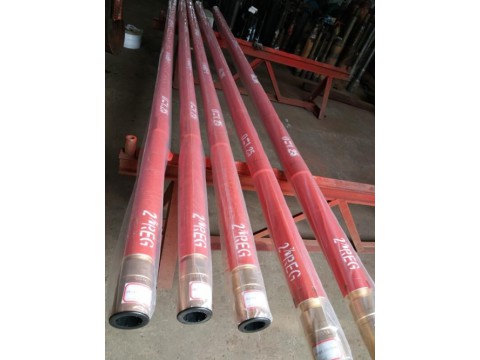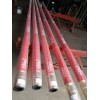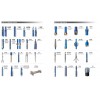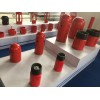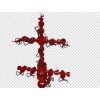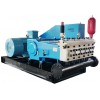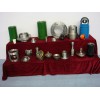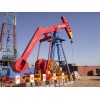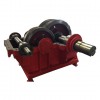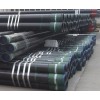Quick Information
- Brand Name:Saigao
- Place of Origin:China
- :
Description
Downhole motor (PDM drill) is a volumetric downhole power drilling tool that uses drilling fluid as power and converts liquid pressure energy into mechanical energy.
When the mud pumped by the mud pump flows into the motor through the bypass valve, a certain pressure difference is formed between the inlet and the outlet of the motor, pushing the rotor to rotate about the axis of the stator, and transmitting the speed and torque to the drill through the universal shaft and the transmission shaft To achieve drilling operations.
A progressive cavity volumetric hole bottom power machine, referred to as auger drill.The auger drill, which uses mud and clean water as the power medium and is conveyed to the bottom of the hole through the center hole of the drill rod, is essentially an energy conversion device that converts liquid pressure energy into mechanical energy. During drilling, the auger directly drives the core tube and drill bit connected to the transmission shaft at the bottom of the hole to rotate. The entire drill string is only used as a channel for conveying high-pressure working medium and a rod supporting the counter torque of the drill bit.
Compared with conventional drilling, screw drilling has many advantages, such as greatly reduced drill pipe wear and high drilling speed.It is the main tool for directional drilling and has played a role in the field of drilling.
The auger drill was first used to punch vertical holes, mainly used to drill a variety of directional holes and special engineering holes (such as mine frozen holes). The maximum drilling depth is 9023 meters. At present, the minimum diameter of auger drills in the world is 44.5 mm and the maximum diameter is 304.8 mm. When auger drilling is used for core drilling, a core tube should be added between the drive shaft and the drill bit to take the core.
The auger drill consists of a bypass valve, a screw motor (rotor and stator), a universal joint, a bearing and a drive shaft. Its core is a screw motor.In the screw motor rotor and stator transmission pairs, the number of stator teeth Z1 is one more than the number of rotor teeth Z2: Z1 = Z2 + 1. Their gear ratio is usually called the transmission ratio, and they can be chosen arbitrarily when designing (1: 2, 2: 3, ..., 9:10). The high speed screw drill should be designed with a small gear ratio screw motor, while the low speed and high torque screw drill should be designed with a large gear ratio screw motor. With the increase of the rotor-to-stator gear ratio, its efficiency gradually decreases; the output torque of the screw drill depends on the working pressure drop through the motor, and the output speed depends on the flow of working medium through the screw motor.
When drilling, conventional drilling equipment such as rigs, mud pumps, drill rods, and rigs are still needed. When constructing a directional borehole, an orienter is used to orient the tilting tool. The tool used to match the auger drill includes curved joints, curved outer tubes and eccentric blocks. The use of auger drill to construct directional holes can improve the quality of drilling, provide accurate geological data, save footage, reduce costs, and solve many engineering problems that cannot be constructed. Therefore, it is a special tool for drilling engineering.
The service life of auger drills is generally 150 to 200 hours.The weak link is that the stator rubber has a low temperature resistance and the bearings are easily damaged. Intensify the research and development of wear-resistant and high-temperature resistant elastic materials and reliable bearing systems for manufacturing stators, so that the working life of screw drills is significantly improved. And develop low-speed high-torque screw for drilling deep holes and ultra-deep holes.
Screw drill composition
The screw drilling tool is mainly composed of four assemblies, such as a bypass valve, a liquid motor, a universal shaft and a transmission shaft.The screw motor is the main component of the drilling tool. Many practical and theoretical analysis results show that if the motor is to work normally and efficiently, the pressure drop that each stage of the motor can withstand is preferably not more than 0.8Mpa, otherwise the motor will leak. The speed decreases quickly, and in severe cases it stops completely and the motor is damaged. (One lead of the motor is level one.) The mud flow used on site should be within the recommended range, otherwise it will affect the efficiency of the motor and even increase wear. The performance parameters of the screw motor are the main performance parameters of the screw drill. The theoretical output torque of the motor is directly proportional to the pressure drop of the motor, and the number of output revolutions is proportional to the input mud flow rate. As the load increases, the number of drilling tool revolutions decreases. Control the torque and speed of downhole drilling tools.
By-pass valve section
The bypass valve is composed of valve body, valve sleeve, valve core and spring. The valve core slides in the valve sleeve under the action of pressure. The movement of the valve core changes the flow direction of the liquid, which makes the bypass valve bypass and close. Each state: During the start-up and down-drilling operations, the valve sleeve and the through hole of the valve body are not closed, and the bypass valve is in a bypass state, allowing the mud in the drill string to bypass the motor and enter the annulus; When the value is set, the valve core moves down and the bypass valve hole is closed. At this time, the mud flows through the motor to convert the pressure energy into mechanical energy. When the mud flow value is too small or the pump is stopped, the spring lifts the valve core and the bypass valve hole is in the open position-in a bypass state.
Motor introduction
The motor consists of a stator and a rotor. The stator is made by injecting a rubber bushing on the inner wall of a steel pipe. The inner hole is a spiral with certain geometric parameters; the rotor is a screw with a hard layer. The rotor and the stator mesh with each other, and the lead difference between the two is used to form a spiral sealed cavity to complete the energy conversion. The rotor of the motor is divided into single and multiple ends. The fewer the number of rotors, the higher the speed and the smaller the torque; the larger the number of rotors, the lower the speed and the greater the torque.
Cardan shaft introduction
The function of the universal shaft is to transform the planetary motion of the motor into the fixed-axis rotation of the transmission shaft, and transmit the torque and speed generated by the motor to the transmission shaft to the drill. Cardan shafts are mostly flexible.
Axis of rotation
The function of the transmission shaft is to transmit the rotary power of the motor to the drill bit, and at the same time to bear the axial and radial loads generated by the drilling weight. The drilling tool transmission shaft structure (shown in Figure 7) manufactured by our company has applied for a national patent, and has many advantages such as longer life and higher bearing capacity.
1. Drilling fluid requirements: Screw drilling tools can work effectively for a variety of muds, including oil-based muds, emulsified muds and clay muds, and even clear water. Mud viscosity and specific gravity have little effect on the drilling tool, but have a direct impact on the pressure of the entire system. If the pressure at the recommended displacement is greater than the rated pump pressure, the mud displacement must be reduced, or it is necessary to reduce Pressure drop in the drill. Impurities such as sand particles in the mud will affect drilling tool performance and accelerate the wear of bearings and motor stators. Therefore, the sand content in the mud must be controlled below 1%. Each type of drilling tool has its own input flow range. only within this range can the drilling tool have higher efficiency. Generally, the middle value of the input flow range should be taken as the best input flow value.
2. Mud pressure requirements: When the drilling tool is suspended, the displacement does not change, so the mud pressure drop through the drilling tool does not change. As the drilling pressure increases when the drill bit contacts the bottom of the well, the mud circulation pressure increases and the pump pressure increases. Drilling can be controlled by the following formula: Drilling pump pressure = circulating pump pressure + drilling tool load pressure. Circulating pump pressure is the pump pressure when the drilling tool does not contact the bottom of the well, also called off-bottom pump pressure. The pressure is about to rise. At this time, the reading of the pressure gauge is called drilling pressure. Off-bottom pump pressure is not a constant. It changes with the depth of the well and the characteristics of the mud. However, in actual operation, it is not necessary to measure the accuracy of the circulating pump pressure at any time. Generally, the off-bottom pump pressure after each single connection is taken as An approximate value, this can fully meet the accuracy requirements of the formula. When the drilling tool is working, when the drilling pump pressure reaches the maximum recommended pressure, the drilling tool produces the optimal torque. Continued increase in drilling pressure will increase the pump pressure. When the maximum design pressure is exceeded, the motor may be braked. Pressure to prevent internal damage to the drill.
Packaging & Delivery
- Packing :customed
- Delivery Lead Time :7-15days
- Supply Ability :1000pcs/month

